Story by Tom Warnke, Executive Director-Palm Beach County Surfing History Project/Surfing Florida Museum

The very distinct and cosmically classic Nomad surfboards label designed in the late 60’s by the uber legendary surf artist, Phil Ogden, for $100. and is still used today. File Photo
Ron Heavyside passed away this Saturday, April 14th. He had been quite well recently, but this week he had stomach pain and was admitted to Bethesda Memorial Hospital in Boynton Beach. The exact cause of his passing is unknown and additional details and information about memorial and services will be announced as soon as they are available.
These notes are some of the memories I have of my longtime friend. They are random and in no way meant to be a comprehensive history. The timeline is in no special order, just like Ron.

Ron Heavyside at Summer Breeze with one of his shapes. Photo Courtesy Heavyside
He was born three weeks after me in 1948 and his family moved to Briny Breezes, Florida in 1962. Ron and I met in high school in 1964, just after I started surfing. He became a design artist with surfboards as his art. I remember Heavyside as one of the first two students at Seacrest High School who shocked everyone in 1964 by wearing their hair ungreased, dry and over their forehead, the same way as the new band, The Beatles. That same year Ron put me in touch with Randy Tubbs. Randy sold me his 1951 Ford woody for $35.00. Half the wood was gone but I drove it for a couple years and sold it for $45.00, always thankful to Ron for helping me find my first drive.
Fast forward to few years ago. While I was on a trip to Hawaii, Darrick Doerner took me to Dick Brewer’s glassing operation on Oahu’s North Shore. As we walked in, I said “Wow, this place reminds me of the old Nomad factory in Hypoluxo.” The glasser looked up at me and said, “Do you know Ron Heavyside?” “I taught him to repair dings in Delray Beach in 1964.” That glasser was the legendary Jack Reeves and he was happy to show me around the place, while reminiscing about working with Ron more than 50 years ago.
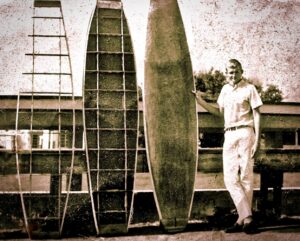
Ron Heavyside with school shop class boards circa 50’s. Photo courtesy Homlesy
So that’s how Ron Heavyside got his start making surfboards. It was at Delray Sporting Goods, fixing dings with Jack Reeves as his mentor. They made boards under the “Caribbean Surfboards” label. The store’s surfboard rental business included about 100 boards that would all be rented by 10am on some weekends. Ron learned to glass the “popout” blanks first, and then made custom Caribbean Surfboards still in high school. Johnny Mac Bird was Ron’s wood shop class teacher in 1965, and since Johnny Mac was a surfer, he got the plans and Ron was one of three students who made hollow wooden boards with plywood decks and pine rails. This board, along with other examples of Ron’s innovative shapes, are part of the collection of the Surfing Florida Museum in Lake Park, Florida.
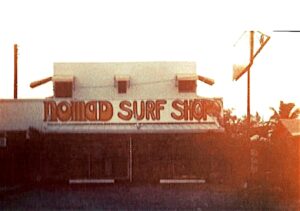
As grassroots and reflective of the times that it can get- Nomad surf shop Circa 1970. Photo: Gary Rugg
After learning to make surfboards in Delray with Jack Reeves, Ron got together with four friends to open the Nomad Surfboards factory on Hypoluxo Road in 1967. (This was the same year Ted James opened Fox Surfboards a couple miles up the road in Lantana.) Each of Ron’s four friends chipped in $250 to start the factory. Ron bought a dozen blanks and a barrel of Dion Resin and Nomad Surfboards was born. After selling quite a few boards that year, Ron was given a small space for a retail showroom in 1968 by his father. It was a 12’x16’ part of his father’s TV shop on A1A in Briny Breezes. Nomad Surf Shop opened there in 1968 and I wrote about the opening in a “Surfing News” column I wrote for the Delray News Journal at the time. The factory craftsman included Ron’s first partner Greg Stickney, along with Ron’s first glasser Gary McGee, known now as “Burry Redbaggies”. Carmen Irving was a primary shaper for Nomad and hand-shaped thousands of boards with Ron over the years.

The early day’s with Ron running a gloss job out at the Hypoluxo Road factory . Photo: Courtesy Tom Warnke
Paul Aho was another artist in the group, who designed most of the Nomad logos and did custom resin pin lines and other art on the boards. Paul recently authored the book “Surfing Florida, A Photographic History”. Right after opening the Nomad factory, Ron visited fellow-artist Bill Ogden in California and paid him $100 to design a Nomad Surfboards logo. That logo is still in use today. Others who influenced the 1960’s “evolution” of Ron Heavyside and Nomad Surfboards were Donald Takayama and David Nuuhiwa, who vacationed with Ron each year in conjunction with Surf Expo. About 20 years ago I asked Ron who influenced him most in surfboard design and production. Ron said he learned much about glossing technique from Tony Channin and shaping from Mike Diffenderfer and Sid Madden. Ron Heavyside’s glossing talents were right there with the East Coast’s best in the day; Skip Ledingham and Fred Grosskreutz. Ron contracted with Disney World to produce hundreds of resin tables for their restaurants and he glassed many hatch-cover tables and resin-topped bars for local establishments.

Ron Heavyside, an east coast surfing classic inside and out. Photo: Courtesy Nomad
Nomad Surfboards was one of the first five exhibitors at what would become Surf Expo. In 1975, ESA held an event called the “Eastern Surfing Summit” in Virginia Beach as part of the ESA’s annual board of directors meeting. There were about seven exhibitors in a room off the lobby at the Holiday Inn. In 1976 the first actual Surf Expo was held in Cocoa Beach and we have a few photos of Ron’s Nomad Surfboards booth at that trade show.In 1969 I organized my first big surfing contest at Boynton Public Beach. Nomad donated the first place trophy for the men’s division and there were more than 100 entries. After many heats surfing some great wind chop, Ron won the first place trophy that he had donated. So he was also a great surfer and his smooth style factored in the win.
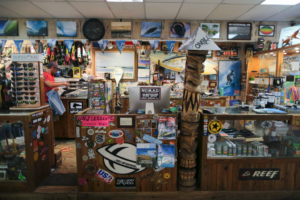
Nomad surf shop interior- a down home space any real surfer would feel right at home in. Photo: Courtesy Warnke
Ron Heavyside was independent. That’s what nomads are. He was unique and did things his own way, when he wanted and how he wanted. I remember calling on Ron as a Costa Del Mar Sunglasses sales rep in 1983. Sometimes it would take a few appointments to finally write an order, or Ron would get interrupted and disappear. Ron could also be generous to a fault. Even if you were just a friend of a friend, you might find your purchase rung up at half off by Ron or his wife Beth. Ron married Beth Walsh in 1974 and she became an expert buyer for womens’ resort fashions, including many well-heeled Palm Beach socialites. Do that too often and you run your business into the ground, but with a prime location on A1A, Ron and Beth built Nomad into a million-dollar operation. At one point there were three retail locations as well as the factory, and after 5 expansions the A1A location became the largest surf shop in Florida. On the men’s side, Jimmy Buffet and Rod Stewart became regular customers.
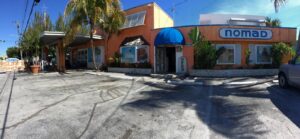
The mothership. Nomad surfshop today in the appropriately named town of Briney Breezes, Florida. Photo Courtesy Nomad
The Nomad factory operation was managed by Ron, while Beth ran the ladies’ side of the store. At one point in the 1970’s, Nomad Surfboards was one of the best-selling surfboards on the U.S. East Coast, turning out more than 40 boards per week and wholesaling boards to dozens of surf shops from Miami to New Hampshire. The Nomad Surf Team was a dominant force on the East Coast competition scene at the time, along with Fox Surfboards from West Palm Beach. Nomad Team riders included 1972 East Coast Men’s Champion Carmen Irving. Other champion team riders included Paul Aho, Kevin Grondin, the Neumann brothers, Rusty Fleetwood, Lenny Nichols, Ozzie Winchester and members of the Cripple Creek Surf Club based at Boynton Inlet. Nomad was also a leader in early skateboarding, manufacturing some of the first laminated decks with kicktails. The Nomad skate team included future Hall of Fame legends Chuck Lagana, Mike Folmer and Scott McCranels, and the team held its own with the original Fox Skateboard Team until Fox became more dominant. The Nomad factory location was a stone’s throw from the infamous “Hypoluxo Ditch”, part of the concrete drainage system installed when I-95 was being constructed in the 1970’s. Nomad skate team trials and memorable sessions took place there.

The progeny and heirs apparent. Ron with son’s Ronnie and Rob. Nomad is no doubt in good hands behind the counter and the planer. Photo: Courtesy Nomad
Ronnie, Ron’s older son, eventually became manager of Nomad and now he and his younger brother Ryan share management of all things Nomad, still at the original location for 50 years. Ronnie is a great surfer and was also talented enough for a baseball scholarship (his swing was compared to Ted Williams) but he chose to stay close to surfing and the shop. Ryan became a pro surfer after qualifying in the 1996 U.S. Team Trials in Huntington Beach for Surfing America’s U.S. Team. He became a menswear model and still travels frequently for photo shoots and freesurfing. Their friend Peter Mendia has been a Nomad team rider for many years.
Ryan and Ronnie continue Ron’s philosophy of giving back to the local surfing community. Nomad has sponsored annual ESA contests for decades and routinely supports local Surfrider Foundation and Surfing Florida Museum events. Ron Heavyside was nominated to the East Coast Surfing Hall of Fame in 2016, and again this year. He is also nominated for the Florida Skateboard Hall of Fame. I’m sure he will be included as a worthy inductee with the next ballots. Hundreds of shop employees, surfboard craftsmen, Nomad team riders and loyal customers have been part of the success of Nomad Surfboards and Nomad Surf Shop over the past 50 years.
I’m sure that Ron’s passing will result in many reunions, a few tears and some great parties.

A Nomad early 70’s twinnie. Yes kids, we used to ride these babies. Photo: Swaylocks.com
This story originally Appeared in Eastern Surfing Magazine online
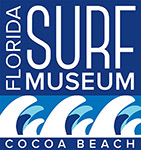

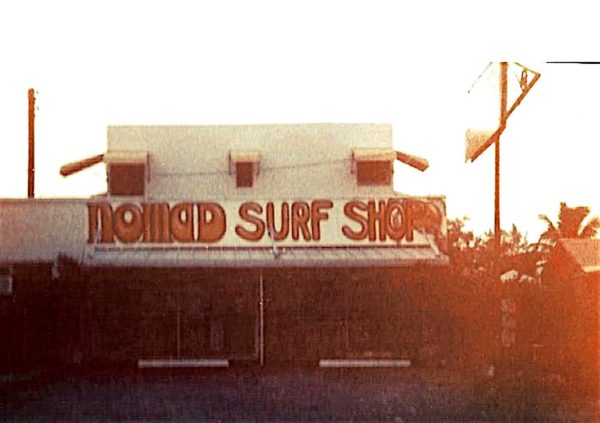
The Heavyside family scheduled the rememberance and paddle out for Ron at 2pm tomorrow, April 29th. It will all take place right behind their stomhop at 4655 North Ocean Blvd, Boynton Beach FL 33435
Lo siento from mazuntte
:-)^2
I knew Ron and Beth since 1976. A great and generous guy. We used to go to concerts together with my ex-partner Rick Kohl and his wife Cathy. Those were the days. I miss both of them. Nomad and Dante’s Den were and are legends in Briny Breezes. Love you guys.
I have a nomad surfboard I believe from 1958? It has a 4 digit serial number a space and the number 58. Is there any info on this board?
JACK REEVES….. IS STILL A LEGEND @ ..PUPUKEA SHOP…..BEST FRIEND EVER 1968 TO 1978….SUNSET BEACH EVERY MORNING…DAWN………………WAS IT RIDEABLE….???…WHO …TO BREAK THE ICE AND PADDLE OUT TO TEST IT…….JACK AND I WERE INVITED TO THE ..”PRO CLASS TRIALS” @ SUNSET…..1976 & 1978…….I BEAT MICHAEL HO IN …ONE HEAT………BLESSING TO JACK A SINCERE PERSON.
AS EVER TOMMY THOMPSON. 59309 KENUI ROAD SUNSET BEACH/HALEIWA……..
I’m 61 now, grew up in AB. I still have my Nomad fish I bought brand new in 1976 at Aqua East. Easily my favorite board after 40 plus years of surfing. Favorite memories are surfing Hurricane David, many many trips to the poles, trips to San Diego, and hurricanes in the gulf in Texas.
Thanks for this website, brings back a lot of good memories.
Fred, it’s great seeing your name! I as well had a Nomad “Swish” which was a little longer and had only 1 fin but shaped like a fish. Truly was the best board I had ever owned to this day. I used to surf the poles with Fred and his younger brother Les on a crowded day at the poles. It used to crowded with only 10-20 people out. Regulars included the Vista brothers,Les and Fred and myself and Jeff Overby. Great memories!
Ronald Richard Heavyside was born in Montreal, moved to Los Angeles at 2, and arrived in Ocean Ridge, Florida, in 1962 just turning 14 and then eventually going on to found a legendary east coast board manufacturing institution and a small, exceptionally vibrant local retail empire with true community spirit like all great surf shops.